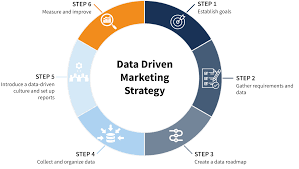The concept of data-driven marketing has developed significantly over time, shaping from traditional mass marketing to highly personalized and analytics based strategies.
In the early 20th century, businesses relied on basic consumer surveys, manual record-keeping, and demographic insights to transform marketing efforts. However, the real shift start with the rise of digital technology and the internet in the late 20th century, allowing businesses to collect and analyze vast amount of customer data.
The 1990s looked the emergence of Customer Relationship Management (CRM) system, authorizing the businesses to track consumer interactions and tailor their marketing efforts more effectively. The introducing of Google Analytics and social media platforms further revolutionized data collection, giving businesses access to immediate customer insights. With advancements in Big Data, Artificial Intelligence (AI), Machine Learning (ML), and Predictive Analytics, modern data-driven marketing has become automated, hyper-personalized, and more efficient than ever before.
Today, businesses use AI-driven chatbots, behavioral tracking, and immediate analytic to integrate customers, optimize efforts, and maximize Return on Investment (ROI). As technology continues to advance, data-driven marketing is set to become even more sophisticated, shaping the future of digital marketing and business growth.
In this blog we’ll explore how data-driven marketing is transforming businesses with complete detail in-depth.

What is Data-Driven Marketing?
Data-driven marketing is a marketing strategy that uses customer data, analytics, and technology to optimize decision-making, increase personalization, and boost marketing effectiveness. Instead of relying on traditional methods, businesses leverage Big Data, Artificial Intelligence, Machine Learning (ML), and predictive analytics to analyze customer behavior, preferences, and purchasing patterns.
This enables businesses to make highly targeted efforts, deliver personalized content, and engage with customers at the right time by the most effective channels.
Through utilizing immediate insights, customer segmentation, and automation tools, businesses can boost customer experience, enhance engagement, and maximize Return on Investment (ROI). Data-driven marketing also support in optimizing marketing budgets through identifying high performing channels and eliminating ineffective strategies.
The Transformational Impact of Data-Driven Marketing on Businesses
Data-driven marketing has fundamentally changed how businesses operate, interact with customers, and optimize marketing efforts. By leveraging Big Data, Artificial Intelligence (AI), Machine Learning (ML), and predictive Analytics, companies can make smarter decisions, increases customer engagement, and improve Return on Investment (ROI).
This transformation is evident in personalized customer experiences, immediate marketing, optimize ad spending, and enhanced customer loyalty
Below are the area where data-driven marketing is making a crucial impact on businesses.
1. Increased Customer Personalization
One of the most crucial advantages of data-driven marketing is customized, and where businesses alter content, product recommendations, and promotional offers based on individual customer behavior, demographics, and past interactions. By utilizing Data Platforms (CDPs) and behavioral tracking, businesses can make highly targeted marketing efforts that higher integration and boost conversion rates.
Amazon and Netflix: Amazon and Netflix use behavioral data to recommend products and movies based on users previous interactions, improving customer satisfaction and retention.
2. Predictive Analytics for Smatter Decision-Making
Predictive analytics authorize businesses to anticipate customer behavior, forecast market trends, and make data-driven decisions. Through analytics historical data patterns, businesses can identify potential buyers, optimize pricing, and refine their marketing strategies. This supports businesses stay ahead of demand fluctuations and customer expectations.
E-Commerce Brands: E-commerce brands use predictive analytics to determine which products will be in high demand during seasonal sales, permitting them to optimize inventory and pricing
3.Immediate Marketing and Automation
With immediate data and automation tools, businesses can integrate customers at the right moment with personalized messages and dynamic content. Marketing automation platforms such as HubSpot, Marketo, and Salesforce support businesses send automated emails, follow-up messages, and retarget users based on their actions.
4. AI-Powered Advertising and Targeting
Usually traditionally advertising ways led to wasted ad spend due to broad, untargeted efforts. Artificial intelligence driven programmatic advertising has changed this through using immediate data to serve ads to the right audience at the right time. AI algorithms analyze user behavior, browsing history, and purchasing patterns to optimize Pay-Per-Click ads, social media ads, and retargeting campaigns.
Google Ads and Facebook Ads: Google ads and Facebook ads use AI-powered bidding strategies to maximize ad performance, making sure businesses get the most value from their as spends.
5.Boost Customer Retention and Loyalty
Businesses can support customer analytics, sentiment analysis, and retention strategies to keep customers integrated for the long term. Companies can design loyalty programs and particular offers for their high value by analyzing customer lifetime value and purchasing behavior.
Starbucks: Starbucks’ loyalty program tracks customer purchases and provides personalized reward, enhancing brand loyalty and repeat purchase.
6. Data-Driven Content Marketing
Content marketing is far more effective when guided through data insights. Businesses use SEO tools, social media analytics, and audience behavior tracking to make good performing content that resonates with their target audience. Brands can optimize their content strategies for maximum impact, through analyzing keywords trends, engagement metrics, and customer feedback.
Benefits of Data-Driven Marketing
Here are key benefits of Data-driven Marketing:
- Businesses can build dynamic customization marketing efforts through analyzing customer behavior, performances, and past interactions. This leads to dynamic engagement, better user experience, and boost conversion rates. Platforms like Netflix and Amazon use data-driven recommendations to alter content for users.
- Data-driven marketing eliminated guesswork through giving actionable insights into customer preferences, market trends, and effort performance. Businesses can make informed decision, optimize strategies, and forecast future trends using predictive analytics.
- By identifying dynamic performing marketing channels and eliminating ineffective strategies, businesses can allocate budgets more efficiently. Data-driven attribution models support marketers understand which platform drive the most conversion, ensuring maximum ROI.
- Companies can analyze customer purchase behavior, sentiment, and also lifetime value to build targeted loyalty programs. This support in customer retention through offering personalized rewards and engagement strategies that keep dynamic value of customers coming back or revisit.
- Immediate data authorize businesses to integrate with customer instantly by automated messages, emails, and chatbots. Marketing automation tools make sure that customers get relevant offers and updates at the perfect moment, enhancing the likelihood of conversion.
- Ai-powered programmatic advertising authorizes businesses to reach the right audience with precise targeting based on browsing behavior, demographics, and interacts. This decreases wasted ad spend and ensures that marketing efforts reach the most relevant protentional buyers.
- Businesses can analyze competitors, strategies, track industry trends, and monitor consumer sentiment by data analytics. This boost companies to refine their approaches, innovate their offerings, and stay ahead of the competition.
Through eliminating ineffective efforts and focusing on data-driven strategies, businesses can decrease overall marketing costs.
When marketing messages are tailored to individual customer needs, businesses see dynamic conversion rates. Personalized recommendation, targeted email efforts, and optimized pricing strategies support drive more sales and business growth.
Best Marketing Analytics Strategies to Follow in 2025 and Beyond

As businesses continue to embrace data-driven decision-making, marketing analytics has become significant for optimizing efforts, increasing customer integration, and maximizing Return on Investment (ROI). with rapid advancement in AI, and marketing analytics in 2025 and beyond will focus on deeper insights, automation, immediate personalization.
Below are the top marketing analytics strategies businesses should implement to stay ahead:
1. Personalized your Efforts
In today’s digital landscape, personalization no longer optional, its crucial for engaging customers, building loyalty, and driving conversion. Businesses that customize their marketing campaigns based on customer data, behavior, and performance see higher engagement, increased sales, and better brand loyalty.
Use Customer data for tailored experience and get data from purchase history, browsing behavior and social media channels interactions to create customized recommendation, email efforts and targeted ads.
2. Automated Marketing Dashboard with AI Insights
AI-driven dashboards like Google Analytics 4 provide predictive insights a d automation for marketers. Use AI-powered dashboards that provide immediate analytics, automated reports, and actionable insights. Theses dashboards will use Natural Language Processing to generate insights in human-readable formats, supporting marketers make data-driven decision faster.
3. Customer Sentiment Analysis
Brands should use AI-powers social listing tools like Brandwatch to detect positive and negative customer sentiments and refine messaging strategies.
Sentiment analysis powered by AI and MLP will support businesses monitor online discussions, customer reviews, and social media intercations to gaugebrand reputation and customer sentiment.
This will permit businesses to address concerns proactively and build stronger relationships.
4. Use Right Tools
Tools are important for getting accurate data, so invest in a robust CRM focusing data collection and for automation marketing. It will support the businesses fill in blind spots and authorize marketers to create right prediction about ahead efforts.
5. Keep Measuring and Boost
Constantly measure the monitoring and boosting marketing campaigns is a basis of data-driven marketing. Businesses should use analytics to track efforts performance, measure ROI and immediate filter strategies. It will support eliminate guesswork and ensures your business marketing efforts are backed through solid data.
6. Use Visual Search Optimization
With the enhancing use of visual search tools like Google Lens, Pinterest Lens, marketers must optimize their content for voice and image-based searches. Analytics tools will track how consumers interact with visual search to filter SEO and ad targeting strategies.
Retail businesses optimize product descriptions for voice search quires like ” Best running shoes for flat feet.”
7. By using Advanced Marketing Attribution Models
As businesses seek more accurate models to measure marketing effectiveness. Multi-touch attribution, AI-powered attribution, and data-driven models will help you to understand which touchpoints contribute most to conversions.
Components of Data-Driven Marketing
Below are the key components of Data-driven marketing:
Data Gathering and Management
The first step in data-driven marketing is gathering customer fata from various sources, including websites, mobile apps, social media, email interactions, and purchase history. Businesses use Customer Data Platforms (CDPs), Customer Relationship Management (CRM) system, and analytics tools to collect, store and organize data effectively.
Proper data governance and compliance with privacy laws such as GDPR and CCPA ensure ethical data collection practices.
Types of Data
There are three types of data for gathering:
- Data First-party: Collect detail straight from your audience through purchase history or getting email address.
- Data Second-party: By partnerships and alignments with others companies gather second-party data.
- Data Third-party: Through external sources get data that gather purchasing trends, interests or broad demographics.
Customer Segmentation and Targeting
Once data is collected, businesses requirement to segment their audience into groups based on demographics, behavior, preferences and buying patterns. This support marketers create personalized efforts, product recommendations, and targeted advertisements that resonate with particular customer groupd. Segmentation ensure that the right message is delivered to the right audience at the right time.
Data Analysis
Data analysis supports the businesses boost efforts performance and shape marketing strategies through discovering trends and patterns.
There are different types of data analysis, including descriptive analysis, diagnostic analysis, predictive analysis and prescriptive. Companies use these techniques to optimize marketing efforts, boost customer experience, and drive revenue growth.
Best Software for Data Analysis
Data analysis needs powerful tools to collect, clean, visualize, and interpret data efficiently. Whether for business intelligence, marketing analytics, financial forecasting, the right software can help make data-driven decisions with precision.
here are top data analysis software:
- Python: Advanced statistical Analysis, Machine Learning, Data Science, widely used in data science. AI research, and predictive analytics.
- Tableau: Best for Data Visualization, Business intelligence and interactive dashboards, and used by businesses, analysts and marketers for visually appealing insights.
- Google Analytics: Web Traffic Analysis, marketing insights, user behavior tracking, and features of Google analytics are, immediate website traffic monitoring, customer behavior insights and SEO analysis.
- HubSpot: Engaged the data from the help of customer, sales and marketing. This use for team collaboration and lead management for more effectiveness.
- Apache Hadoop: Its Handles massive datasets, scalable architecture, integration with cloud platforms.
- Power BI: Cloud-based analytics. immediate dashboards, AI-powered insights, its best for businesses intelligence, Corporate Data Analysis and for reporting.
Personalization and Customer Experience
Personalization is critical component of data-driven marketing that enhances the customer experience through delivering alter content, customized offers, and dynamic website interactions. Businesses use AI-powered chatbots, personalized emails, and product recommendation to create meaningful customer interaction. The more personalized the experience, the higher the engagement and conversion rates.
Targeting and Segmentation
Targeting and segmentation are crucial marketing strategies that supports businesses finding the right audience with effective messaging. Segmentation requires dividing a broad customer base into smaller, more defined groups based on shared characteristics like as demographic , geography, psychographics, and behavior. By analyzing customer needs and preferences, businesses can tailor their products, services, and marketing efforts to different market segments.
Demographic segmentation categorizes consumers based on age, gender, income, and education, while geographic segmentation focuses on location, climate and urban vs rural markets.
Similarly, psychographic considers lifestyle, values, and interests, whereas behavioral segmentation examines buying habits, product usage, and brand loyalty.
Once segmentation is complete, businesses use targeting to focus on the most profitable and relevant segments. Different targeting strategies support companies optimize their marketing efforts. Mass marketing applies a single strategy to a broad audience, whereas differentiated marketing alters efforts to many segments with unique messages. Niche marketing focuses in highly specific market, while micro-marketing personalizes offers for individual customers using AI and data analytics.
Common Data-Driven Marketing Challenges
Businesses usually face several challenges in implementing and managing data-driven strategies effectively. Below are some of the most common challenges and their impact on marketing success:
Data Gathering and Quality Issues
In data-driven marketing gathering accurate, reliable and relevant data is the biggest challenges. Businesses often struggle with incomplete, outdates, or inconsistent data, leading to poor insights and ineffective marketing decisions. Moreover, integration data from multiple sources such as website, social media, CRM systems, and third-party tools can create discrepancies, making it difficult to get a single, unified view of the customer.Data Privacy and Regulation Concerns
With increasing global regulation like General Data Protection Regulation (GDPR) and California Consumer Privacy Act (CCPA), businesses must check ethical and legal data collection practices. Improper handling of customer data can lead to legal penalties, loss of trust, and reputational damage. Marketers requirement to implement transparent data polices, secure storage system, and customer consent mechanisms to comply with data privacy laws.Integrating Multiple Data Sources
Marketers collect data from various platform such as Google Analytics, CRM software, social media, and email marketing tools. However, integrating these sources into a single, cohesive system can be challenges due to different data formats, inconsistencies, and technological limitations. Without proper data integration, businesses may struggle to create a holistic view of customer behavior and deliver consistent marketing experiences.Measuring Marketing ROI and Performance
Determining the true impact of data-driven marketing efforts can be difficult due to complex customer journeys and multiple touchpoints. Traditional last-click attribution models usually fail to capture the full picture of how different marketing channels contribute to conversion. Businesses need advanced multi-touch attribution models, AI-powered insights, and immediate analytics dashboards to measure and optimize marketing performance accurately.Data Security and Cyber Threats
As businesses rely more on data, the risk of cyberattacks, data breaches, and unauthorized access increase. Protecting sensitive customer data needs strong cybersecurity measures, encryption, and regular security audits. A single data breach can lead to financial losses, legal consequences, and a damage companies reputation.Conclusion
Data-driven marketing is revolutionizing businesses through authorizing smarter decision-making, customer insights, and dynamic personalized experiences. By boosting Bid Data, AI, predictive analytics, and marketing automation, companies can create more effective efforts, getting marketing spends, and improve Return on Investment (ROI). The best strategies, such as customer segmentation, immediate personalization, AI-powered advertising, and predictive analytics, ensure that businesses reach the relevant audience with the message at the right time.
However, while data-driven marketing permits, “Immense growth opportunities”, businesses must also navigate challenges such as data privacy, integration complexities, and AI-driven automation risks. The key to success lies in balancing technology with human intelligence, making sure ethical data usage, and continuously optimizing strategies based on immediate insights.
In an increasingly digital and competitive world, businesses that embrace data-driven marketing will gain a significant edge, fostering stronger customer relationships, driving higher conversions, and achieving long-term growth. The future of marketing belongs to those who can turn data into actionable insights and innovation making data-driven strategies not just an advantage but a necessity for sustained success.





